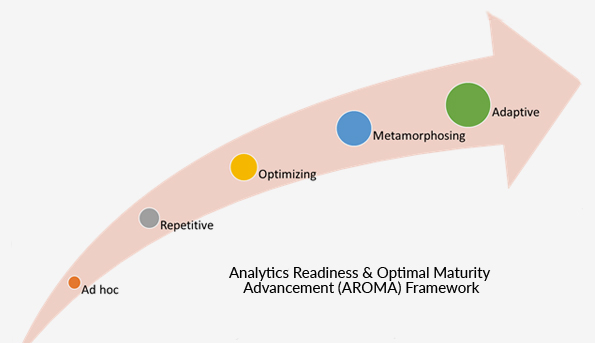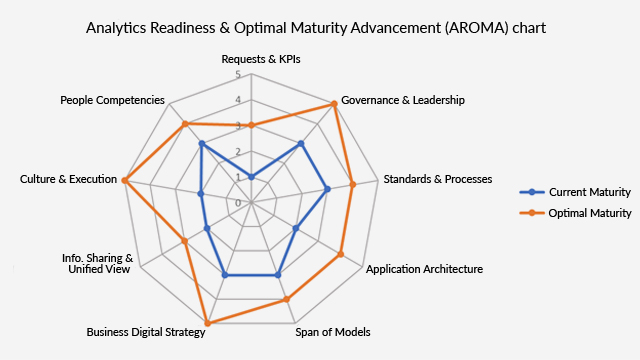Analytics Readiness & Optimal Maturity Advancement (AROMA) Framework

Digital & Technology
339 week ago — 7 min read
Analytics is defined as the scientific process of transforming data into business insights for supporting and making better decisions. The Analytics Readiness & Optimal Maturity Advancement (AROMA) framework has been designed with the sole purpose of enabling organisations to measure their ‘analytics readiness’ in an objective, measurable and unbiased manner. Subsequent to the analytics readiness assessment, it is necessary to collaboratively work with the organisation's executive leadership to define the optimal target analytics maturity and finally identify a transformative roadmap with a detailed action plan to successfully advance to the desired maturity.

The AROMA framework categorises the analytics readiness at the enterprise level into one of the 5 maturity levels – Ad hoc, Repetitive, Optimizing, Metamorphosing and Adaptive. The 9 factors that contribute to the analytics readiness of an organisation have been indicated below. At each factor level, characteristics have been outlined to clearly indicate where the enterprise ranks based on a qualitative and quantitative assessment.
The 9 key factors encompassing the requirements of an analytics future-ready organisation are:
- Source of Requests & defining KPIs - Are the requests made in an ad hoc manner to the analytics organisation from key stakeholders? Is there a structured pipeline of requests that are provided in advance across the enterprise? Are the individual businesses geared to addressing some of the analytics requests themselves separate from an enterprise analytics team? Are the related KPIs managed across the enterprise through the full value chain or is managed department wise?
- Governance & Leadership - Who drives the governance of the analytics lifecycle within the organisation? This involves all stages right from getting the data, cleaning for further processing, producing consumable descriptions, creating, improving and finalizing the work in progress models and selecting the final model? Is it Information Technology driven, business driven, competency centres driven or enterprise-wide with broad business leadership involvement?
- Standards & Processes - Are there defined analytics standards and structured processes that are uniformly applied and rigorously followed across all business analytics requirements? Do these standards and processes serve all Business needs or are they additionally tailored within the businesses of an enterprise? Is there a periodic audit check with log records maintained to verify strict adherence and any required follow-up action?
- Analytics Application Architecture - Is the adopted analytics application architecture capable of meeting the Enterprise requirements? Is it scalable enough to handle any spurts of demand in a robust manner? Can the Infrastructure be paid for on the basis of actual usage and capacity requirements if the demand is fluctuating based on various factors? Is the security of the data ensured through the architecture at granular permission levels?
- Span of Analytics Models - Do the commonly used analytics models span the entire breadth of available possibilities within the enterprise? The order is quite definitive both in terms of complexity and ease of understanding and adoption by business - namely descriptive, diagnostic, predictive, prescriptive and cognitive. Cognitive is very expansive ranging from machine learning, natural language, image & video processing in various integrated artificial intelligence combinations.
- Business & Digital Strategy Alignment - Is the digital transformation strategy determined and co-created with the CDO (Chief Data Officer) on board? Or is the CDO/enterprise analytics team brought onboard only during the strategy execution stages? This is an important reason for many Digital Transformations failing due to unrealistic expectations as well as sometimes, under-utilisation of available stable analytics technologies/ methods.
- Information Sharing across Silos with Unified View of Business - Is the organisation consuming information and generated insights in silos based on departmental requirements? Or does it adopt enterprise wide analytics best practices and information sharing with a unified view of the business processes and overall strategic direction? These factors are an important determinant of customer satisfaction and being able to derive Value across the entire business chain.
- People Culture and Adoption - How adaptive and resilient are the people talent within the enterprise? Does it span from slow-moving and averse to innovation/ risk taking characteristics of traditional companies or is it closer to being more agile and open to innovation with a fail-fast mentality? Given the fast-evolving nature of analytics, people culture is an important determining factor.
- People Competencies - How do the analytics organisation’s competencies rank on the business understanding, data science and technology acumen dimensions? A true blood analytics savvy organization will be characterised by necessarily clubbing together these competencies so varying perspectives are adequately represented on all analytics project teams. Missing competencies usually lead to half-baked solutions that rarely progress beyond idea stage.
Applying the AROMA framework to an organisation has resulted in the chart shown in the figure below. The blue line indicates the current maturity and the orange line indicates the optimal maturity desired within the same organisation. The gap between the blue and orange lines outline the required action steps to be addressed and completed in the optimal maturity advancement roadmap. This detailed roadmap is further customised for each organisation detailing each of the 9 factors with an estimated time line for completion.

Using the AROMA framework is critical for any enterprise seeking to assess its current analytics readiness and taking the next steps towards reaching its desired optimal analytics maturity level in a well-planned and phased manner. Applying the AROMA framework will assist the enterprise to identify an optimal maturity target and transform into a digitally savvy and future analytics ready well-oiled machine delighting its customers, employees and supply chain partners.
To explore business opportunities, link with me by clicking on the 'Invite' button on my eBiz Card.
Disclaimer: The views and opinions expressed in this article are those of the author and do not necessarily reflect the views, official policy or position of GlobalLinker.
Posted by
Lester Sebastiao FernandesI am looking to connect with other business owners who need to extract analytical insights from current data and take informed decisions. We make your Data Insights journey easier...
View Lester 's profile
Other articles written by Lester Fernandes
Technology & business trends: 2019 & beyond
332 week ago
Most read this week













Comments
Share this content
Please login or Register to join the discussion